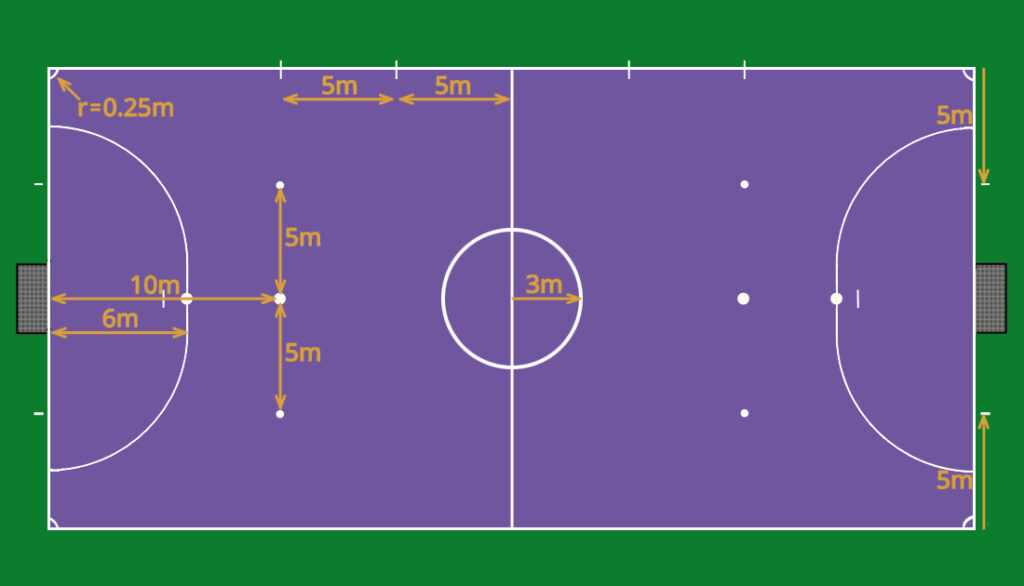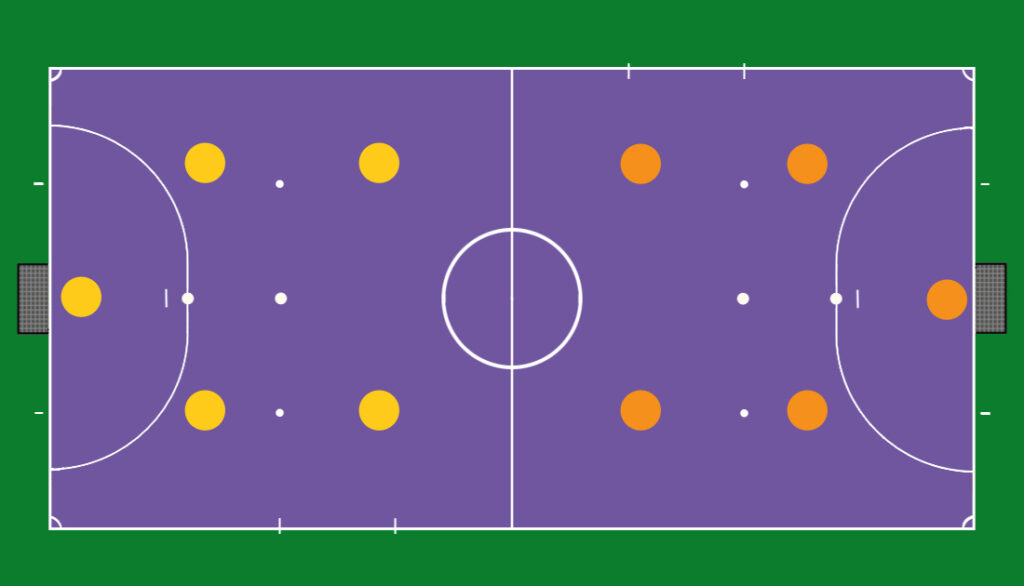Futsal is a fast-paced indoor soccer variant. It emphasizes skillful play and quick decisions. Originating in South America, futsal is played on a smaller court. It uses a smaller, heavier ball compared to traditional soccer. Futsal rules are key for players, coaches, and fans. They help them appreciate and engage with the game. This guide covers the basic rules of futsal. It includes court sizes, scoring, and penalties.
Futsall Court Dimensions and Equipment
Futsal is played on a hard indoor court. It is designed for skillful, precise play. The court dimensions and equipment are tailored to create a fast-paced, technical game.
Court Dimensions:
- Length: 25 to 42 meters (82 to 138 feet)
- Width: 16 to 25 meters (52 to 82 feet)
Key Markings:
- Penalty Area: A semi-circle with a radius of 6 meters (19.7 feet) from the goal line.
- Penalty Spot: Located 6 meters (19.7 feet) from the center of the goal.
- Second Penalty Spot: Positioned 10 meters (32.8 feet) from the goal for accumulated fouls.

Equipment:
- Ball: Smaller and heavier than a soccer ball, designed to reduce bouncing.
- Goals: 3 meters (9.8 feet) wide and 2 meters (6.6 feet) high.
- Player Gear: Includes jerseys, shorts, socks, shin guards, and flat-soled shoes suitable for indoor play.
These dimensions and equipment specifications ensure the game remains fast-paced and skill oriented.
Team Structure and Positions
A futsal match features two teams of five players, including a goalkeeper. The smaller team and court require players to be versatile and skilled.

Key Positions:
- Goalkeeper: Protects the goal and manages ball distribution from within the penalty area.
- Defenders: Focus on preventing goals, often playing with one or two teammates.
- Midfielders: Connect defense and attack, requiring excellent ball control and passing.
- Forwards: Primarily responsible for scoring goals, needing agility and sharp shooting skills.
Futsal’s fast pace lets players switch roles often. It emphasizes teamwork and adaptability.
Match Duration and Timing
Futsal matches are fast-paced and intense. They have strict timing rules to ensure continuous play.
Match Duration:
- Halves: Two halves of 20 minutes each of effective playing time.
- Halftime: 15-minute interval between halves.
Timekeeping:
- Timeouts: Each team gets a one-minute timeout per half.
- Clock Management: The clock stops whenever the ball is out of play.
These rules keep the game dynamic and prevent time wasting.
Starting and Restarting the Game
Proper procedures for starting and restarting the game keep it fair and flowing.
Starting the Game:
- Kickoff: From the center of the court, with the ball stationary and players in their respective halves.
Restarting the Game:
- After a Goal: Restarted with a kickoff from the center of the court by the team that conceded the goal.
- Out of Play: Resumed with a throw-in, corner kick, or goal clearance, depending on how the ball went out of play.
These procedures ensure a smooth flow and equal opportunities for both teams.
Playing Rules and Regulations
Futsal’s playing rules are designed to promote skillful play and maintain game flow.
In Play and Out of Play:
- Ball in Play: Remains in play as long as it stays within the court boundaries.
- Ball Out of Play: When it crosses the sideline or goal line.
Contact Rules:
- Physical Contact: Limited; excessive force and dangerous tackles are not allowed.
- Fouls: Includes holding, pushing, and tripping, leading to free kicks.
Goalkeeper Rules:
- Handling: Allowed only within the penalty area; must release the ball within 4 seconds.
- Distribution: Must be done within 4 seconds of gaining possession.
These futsal rules help maintain a fast-paced, skill-focused game.
Substitution Procedures
Substitutions in futsal are designed to keep the game energetic and allow tactical adjustments.
Substitution Rules:
- Unlimited Substitutions: Allowed throughout the match.
- Procedure: Must occur during stoppages in play, with players entering and exiting at the designated zones.
- Timing: Substitutions must be signaled by the referee.
These procedures ensure efficient handling of substitutions and maintain game flow.
Futsal Scoring and Determining the Winner
Scoring in futsal is straightforward, with specific rules for tie-breaking.
Scoring Goals:
- Validity: A goal is scored when the entire ball crosses the goal line.
Tie-Breaking Procedures:
- Extra Time: Two additional periods of 5 minutes each if tied at the end of regular time.
- Penalty Shootout: If still tied after extra time, a series of penalty kicks determines the winner.
These procedures ensure a fair and exciting resolution to the match.
Fouls, Penalties, and Free Kicks
Futsal rules on fouls and penalties ensure fair play and maintain the game’s pace.
Types of Fouls and Consequences:
- Minor Fouls: Result in an indirect free kick.
- Accumulated Fouls: After five fouls, the next foul gives a direct free kick from the Second Penalty Spot (10 meters or 32.8 feet) without a wall of defenders.
- Serious Fouls: Result in a direct free kick or penalty kick if inside the penalty area.
Free Kicks and Penalty Kicks:
- Direct Free Kick: For serious infractions, it can be taken directly at the goal.
- Indirect Free Kick: For minor fouls, it must touch another player before scoring.
- Penalty Kick: Awarded for fouls inside the penalty area; a direct shot at the goal.
These rules help manage game flow and fairness.
Conclusion
Futsal is a fast, exciting sport. It requires skill, strategy, and quick thinking. Players, coaches, and fans must know the futsal rules. This includes the court dimensions, team structure, fouls, and scoring. Mastering these futsal rules will boost your enjoyment of this fast-paced indoor sport. You’ll better understand how to play and follow the game.







